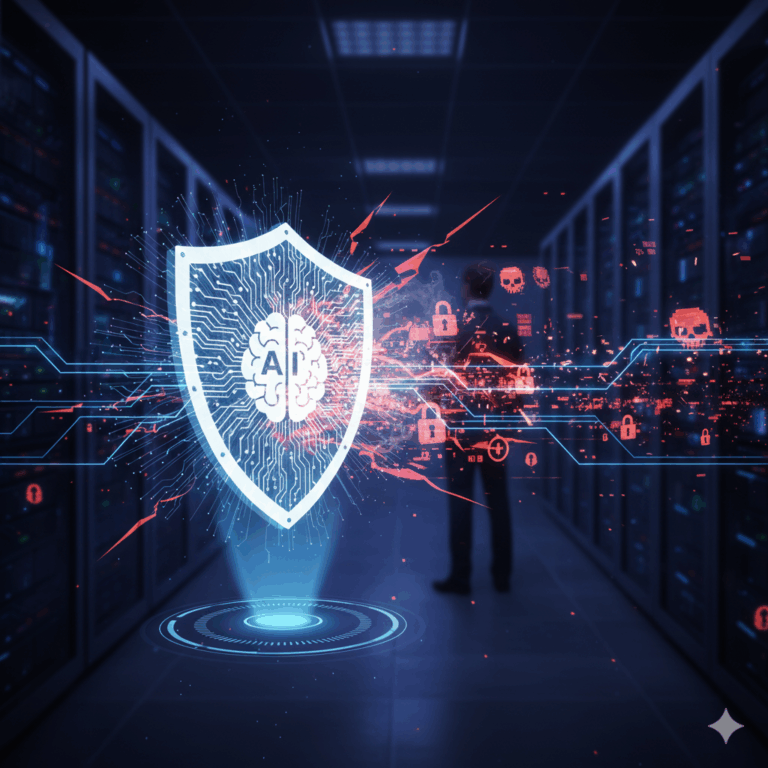Artificial Intelligence has rapidly evolved from a powerful innovation driver into the new frontline of cybersecurity. While companies embrace AI to automate workflows, analyze data, and boost productivity, cybercriminals are leveraging the same technology — but with entirely different goals.
What once required weeks of preparation, coding expertise, and reconnaissance can now be executed in minutes with a few well-crafted AI prompts. Today, hackers can generate phishing emails, clone executive voices, identify vulnerabilities, and adapt malware — all automatically and at scale.
The result is a new era of cyberattacks: faster, more precise, and alarmingly convincing.
AI has become a force multiplier for threat actors. It removes human limitations, enables attacks that learn and evolve, and allows criminals to target multiple victims simultaneously — without requiring deep technical knowledge.
In this article, we’ll explore how attackers are weaponizing AI in 2025, the most dangerous emerging tactics you need to know, and the concrete defensive measures your organization can implement right now to stay one step ahead.
Artificial Intelligence has become the ultimate multiplier of criminal efficiency. It extends the reach of attackers, replaces missing technical expertise, and automates entire attack chains — from reconnaissance to execution. In essence, AI turns a single hacker into an entire cyber operation.
1. Next-Generation Phishing and Social Engineering
The era of poorly translated, typo-filled spam emails is over.
Modern generative AI models produce flawless, context-aware messages that are nearly indistinguishable from genuine business correspondence. Attackers no longer rely on guesswork; they rely on data — and AI connects the dots faster than any human could.
Hyper-personalization at scale
Cybercriminals use AI to analyze publicly available information such as LinkedIn profiles, company press releases, blog articles, or social-media updates. Within seconds, a language model can craft a message that perfectly mirrors the tone, vocabulary, and communication style of your organization.
A phishing email may reference a real project, include the correct job title of a supervisor, and even adopt the phrasing your finance team typically uses. This deep contextual accuracy disarms recipients: the message looks legitimate, feels familiar, and therefore bypasses instinctive suspicion.
What used to be a generic “Dear Sir or Madam” spam message has evolved into a hyper-targeted social engineering weapon — personalized at scale by AI.
Deepfakes and identity deception
Equally alarming is the rise of synthetic identity attacks powered by deepfake technology.
With just a few seconds of publicly available audio — for instance, from a conference speech or a YouTube interview — an attacker can clone an executive’s voice with uncanny precision.
A single phone call, seemingly from the CEO or CFO, may urge an employee to approve an “urgent wire transfer” or release confidential data.
Because the voice sounds authentic, victims comply before verifying the request.
These voice-cloning scams, combined with AI-generated emails, have supercharged the classic Business Email Compromise (BEC) scheme. According to multiple law enforcement reports, BEC remains one of the most financially damaging cybercrimes worldwide, causing billions in annual losses — and AI deepfakes are now making it faster, cheaper, and harder to detect.
Beyond email: the new social-engineering frontier
Some attackers take it a step further by generating real-time video deepfakes for fake video calls or online meetings. Imagine seeing your “CFO” appear on camera — speaking, blinking, and gesturing naturally — while instructing you to bypass standard approval procedures.
This is no longer science fiction. Deepfake-as-a-service platforms are easily accessible on the dark web, lowering the barrier for sophisticated social-engineering attacks that blend visual, auditory, and textual deception.
2. Automated and Adaptive Malware
Artificial Intelligence has fundamentally changed the rules of the malware game.
What once required deep coding skills, time, and manual testing can now be done automatically.
Cybercriminals are using AI-driven systems to generate, optimize, and adapt malicious code in real time — creating malware that is faster, stealthier, and far more resilient than traditional threats.
Today’s attacks are rarely static. Instead, we are seeing polymorphic and metamorphic malware that changes its “appearance” every time it runs. Behind these mutations is often not a human hacker but an autonomous AI engine. This system continuously analyzes how antivirus programs, EDR agents, or sandboxes respond — and then rewrites its code to avoid detection. It can alter its structure, encryption routines, and runtime behavior within seconds, rendering traditional signature-based detection nearly useless.
Even more concerning is the rise of automated vulnerability discovery. AI-powered bots can scan entire corporate networks in minutes, identifying open ports, outdated software, misconfigured cloud permissions, or unpatched plugins.
Previously, such reconnaissance required hours of manual work by skilled attackers. Now, it happens continuously and autonomously — 24/7 — and as soon as a weakness is found, an exploit can be generated and deployed automatically.
AI is also enabling a new wave of “living off the land” attacks, where legitimate administrative tools and system processes are weaponized. Instead of introducing obvious malicious binaries, AI identifies trusted native utilities already present on the system — PowerShell, WMI, PsExec, or cloud management APIs — and writes scripts that execute malicious tasks under the guise of normal activity. Because these processes are legitimate, most security tools don’t flag them immediately, giving attackers a head start.
The implications are clear: defensive strategies based solely on signatures, blacklists, or manual patching cycles are no longer sufficient.
In the age of adaptive, AI-powered malware, organizations need behavioral and context-aware security that can detect anomalies rather than just known threats.
Modern Endpoint Detection and Response (EDR) platforms that leverage machine learning can monitor for unusual process chains, memory spikes, or suspicious outbound connections — identifying potential compromises before an exploit fully executes.
Complementing this, continuous threat hunting and hypothesis-driven analysis can help uncover automated campaigns that operate just below the detection threshold.
A strong vulnerability and patch management process is equally essential. Automated asset discovery, combined with prioritized remediation, reduces the window of opportunity that AI-driven bots depend on. Network segmentation and the principle of least privilege ensure that even if one endpoint is compromised, the attacker’s movement is limited and contained.
Some defenders are turning to deception technologies — honeypots and decoy systems designed to lure and trap AI-driven tools. These act as early-warning beacons, exposing automated behavior before it reaches critical systems.
Finally, no matter how advanced your technology is, rapid response remains key. AI-powered attacks can scale instantly, so every organization needs a tested incident response playbook that defines clear roles, escalation paths, and containment procedures. Practice those scenarios regularly, automate isolation workflows, and ensure that both IT and management know how to respond when an automated outbreak begins.
In short: AI-driven malware is dynamic, fast, and constantly evolving.
To fight it, your defense must be equally intelligent — built around behavior, speed, and resilience. By combining proactive detection, automated response, and disciplined patch management, you can stop most automated attacks before they ever reach your core systems.
3. Intelligentes Passwort-Cracking
Password attacks have been reborn in the age of AI. Instead of mindlessly trying billions of combinations, modern attackers feed models with real-world breach data and let the algorithms learn how people actually build passwords — the predictable patterns, favorite numbers, keyboard walks, pet names, and cultural references that humans reuse across accounts. The result is not brute force in the old sense but informed guessing at scale: attacks that prioritize likely candidates first and adapt as they learn which guesses succeed.
These AI-driven approaches turn credential stuffing and targeted guessing into surgical tools. Where credential stuffing once relied on replaying leaked username/password pairs across services, intelligent cracking augments that with pattern-based generation tailored to a specific org or demographic. For example, if a dataset shows an employee base that often appends “2022” to hobbies or hometown names, the model will generate thousands of high-probability variants in seconds. When attackers combine that with automated account-testing infrastructure, they can compromise weak and even many “medium-strength” passwords far faster than human threat actors ever could.
What makes this especially dangerous for businesses is the persistent reality of password reuse and the slow adoption of stronger auth methods. Many organizations still accept single-factor logins for a surprising number of services — and some critical admin interfaces remain protected only by passwords that are likely derivable from public information. AI simply widens the payoff for attackers who already exploit these human habits.
Defending against this wave is straightforward in principle but demands discipline. Require and enforce strong, unique credentials everywhere, and pair them with phishing-resistant multi-factor methods rather than SMS or simple one-time codes. Move toward passwordless options where feasible — platform authenticators, FIDO2/WebAuthn, and hardware tokens dramatically reduce the attack surface that credential-guessing relies on. Implement robust rate-limiting and anomaly detection on authentication endpoints so that automated guessing attempts are throttled and quickly blocked. Integrate breached-credential checks into logins and identity lifecycle processes, and fail fast when a login attempt matches a known-compromise pattern.
On the backend, reduce the value of stolen hashes by using modern, slow password hashing (Argon2, or properly tuned bcrypt/scrypt), unique salts per user, and strict controls on who can access authentication stores. Monitor for unusual sign-in patterns — impossible travel, new devices, or repeated near-miss passwords — and require step-up authentication or temporary locks when risk indicators appear. Finally, make credential hygiene easy for users: enterprise password managers, single sign-on with enforced strong policies, and clear user education about reuse are far more effective than hoping users “do the right thing.”
In short, AI hasn’t made password attacks mystical — it has made predictable human behavior far more exploitable. Treat authentication as a system, not a checkbox: combine stronger verification, smarter detection, and fewer passwords, and you will remove the biggest leverage AI gives to attackers.
The Defense: How to Prepare Your Business for the Age of AI
The good news is this: Artificial Intelligence is not only a weapon for attackers — it can also be your strongest ally.
Organizations that integrate AI proactively into their cybersecurity strategy can detect threats earlier, respond faster, and even neutralize attacks before they begin. Defense in the age of AI means more than stopping incidents; it means predicting them — and that’s exactly where intelligent security systems excel.
AI-Driven Security as an Early-Warning System
Cyberattacks now unfold in seconds. In many cases, only a few minutes separate an initial breach from full data exfiltration.
Traditional security tools — firewalls, antivirus, or static rule sets — are too slow for this reality.
Modern defense platforms use machine learning and behavioral analytics to understand what “normal” activity looks like across your network. These solutions, known as User and Entity Behavior Analytics (UEBA), continuously monitor how employees, endpoints, and applications interact.
When an account suddenly behaves differently — for example, logging in from a foreign location, accessing sensitive files after hours, or generating unusual traffic volumes — the system immediately flags or isolates it.
Even more powerful is automation. Advanced platforms can respond autonomously, locking compromised accounts, isolating infected devices, or blocking suspicious processes before they spread.
This blend of artificial intelligence, automated response, and human oversight creates the agility needed to defend modern environments.
At the same time, AI strengthens your visibility across the threat landscape.
Threat intelligence systems powered by machine learning can analyze millions of indicators every day — IP addresses, domains, file hashes, and behavior patterns — and filter out what truly matters to your organization.
That means faster decisions, fewer false positives, and better use of your security team’s time.
Strengthening the Human Firewall
No algorithm is as adaptive or as intuitive as a well-trained human.
Since many AI-driven attacks rely on psychological manipulation, your employees remain the most critical layer of defense.
Cybercriminals know that the easiest entry point isn’t always a firewall — it’s trust.
A convincing email, a familiar voice, or a friendly “urgent” request can be all it takes to bypass your defenses.
That’s why awareness training is no longer optional. It must evolve to include AI-based threats: how to recognize a deepfake voice, spot synthetically generated messages, and question sudden requests that sound “off.”
Regular, scenario-based training keeps this awareness fresh.
Simulated phishing and social-engineering exercises are particularly effective when they reflect real-life situations — realistic but safe.
The goal is not to shame employees but to sharpen instinct. Only those who understand what AI-generated deception looks and feels like will react calmly and correctly when it happens for real.
A strong security culture emerges when technology and people work together — when employees see themselves as part of the defense, not as its weakest link.
Proven Fundamentals Still Matter
Even the most advanced AI defense stands on classic security foundations. The most effective protections are often the simplest — but they must be enforced consistently.
Multi-Factor Authentication (MFA) remains one of the most effective barriers against account compromise.
Even if a password is guessed or stolen through AI-driven attacks, MFA prevents unauthorized access.
Whenever possible, use phishing-resistant methods such as FIDO2 tokens or hardware authenticators instead of SMS codes.
Strong patch and update management is equally vital.
AI-powered bots constantly scan the internet for unpatched systems and outdated software.
If your business delays updates, you become a prime target for automated exploitation.
Adopting the principle of least privilege limits the damage a single compromised account can cause.
Employees should only access the systems and data required for their role. This simple discipline drastically reduces lateral movement during a breach.
Finally, implement secure communication policies.
Define clear verification steps for financial transactions, data requests, or sensitive changes — for instance, a mandatory callback procedure or dual-approval system.
When your employees know that no legitimate executive will ever request urgent payments or credentials via chat or email, most social-engineering attacks lose their power instantly.
The Key Is in the Combination
There is no silver bullet in cybersecurity. But the combination of intelligent technology, informed people, and disciplined processes creates a defense ecosystem that can stop even sophisticated AI-driven attacks before they reach your core systems.
Adopt a proactive mindset: detect early, respond fast, and empower your team to think critically.
In doing so, you transform AI from a potential risk into a strategic advantage — building a business that is resilient, adaptive, and secure in the age of artificial intelligence.
Conclusion: How Hackers Use AI Against Businesses and How to Defend
The rise of artificial intelligence has redefined the battlefield of cybersecurity. What once took weeks of manual effort can now be executed in seconds — by algorithms that never rest. Understanding how hackers use AI against businesses and how to defend is no longer optional; it’s a core requirement for survival in the digital age.
Cybercriminals are leveraging AI to automate phishing, create adaptive malware, and exploit human trust at scale. But the same technology that fuels these threats can also empower your defense. When AI is combined with vigilant employees, modern detection tools, and disciplined governance, your organization gains more than protection — it gains resilience.
Building a secure future means embracing AI, not fearing it.
Use it to predict, detect, and neutralize threats before they reach your systems. Train your teams to recognize manipulation. Strengthen your processes and authentication. In doing so, you turn AI from an attacker’s advantage into your competitive edge.
Cybersecurity in 2025 isn’t about fighting technology with firewalls — it’s about fighting AI with smarter AI.
Please also read:
Can AI Help Your Company Avoid Hacker Attacks?
Cybersecurity 2025: The Biggest Risks for Businesses – and How to Protect Your Company
How Hackers Break Into Microsoft 365 — and How You Can Stop Them
Follow me on Facebook or Tumblr to stay up to date
Connect with me on LinkedIn
Take a look at my services
And for even more valuable tips, sign up for my newsletter
Visit my members area for regular cybersecurity insightsand course updates
An AI-powered cyberattack uses artificial intelligence or machine learning to automate or enhance traditional hacking techniques.
Attackers use AI to analyze data faster, personalize phishing messages, evade detection, and even modify malware in real time.
In short — AI makes old threats faster, smarter, and harder to recognize.
Hackers use large language models (LLMs) like ChatGPT-style tools to write grammatically perfect, context-aware emails in any language.
They analyze LinkedIn profiles, company websites, and even press releases to mimic a colleague’s tone or style.
The result: personalized phishing messages that look 100 % legitimate — often combined with deepfake voice calls or video messages to increase credibility.
.
Yes — to a certain degree.
AI can generate or mutate malicious code, test it against antivirus engines, and automatically adapt when detected.
This type of self-modifying or polymorphic malware is much harder to block because every instance looks different.
Some attackers also use AI to find vulnerabilities faster by scanning networks and analyzing system configurations automatically.
Absolutely. AI makes cybercrime scalable — meaning attackers can target hundreds of SMEs automatically, not just big corporations.
Smaller companies often have weaker defenses, making them attractive targets.
Strong passwords, MFA, and a basic incident-response plan are essential for every business, regardless of size.
Definitely — when done responsibly. AI helps detect anomalies, automate patching, and monitor large networks in real time.
However, it must be implemented securely: protect training data, restrict system permissions, and regularly audit AI tools for vulnerabilities or data leaks.
D




